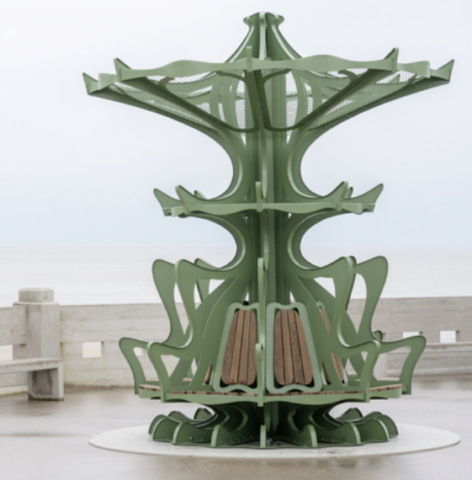Logos: Bridging Commerce and Art in a world of Symbols.
By Likhitha Kommu
What comes to mind when you see an image of a tick mark or an apple with a bit mark? It’s more than just a visual clue, a logo, to a brand; it’s an opportunity for an emotional bond. The Nike swoosh is a call to action that appeals to both athletes and dreamers. It is the hum of inspiration, the pulse of tenacity, and the whisper of motivation. With its playful nibble removed, the Apple logo evokes a sense of innovation, temptation, even play, and the excitement of possibilities. A great logo is one that not only is instantly recognisable but also highlights the core values of the company it represents But what happens when the logo gets subverted?
The image on left during Frieze London from Lehmann Maupin Gallery by Mandy El Sayegh
Brand’s visual love letters to their customers, known as logos, communicate with them in an emotional language that goes beyond words. They are equally as important as a firm handshake, a self-assured stride, or a friendly smile when meeting someone for the first time because they leave a lasting impression that can affect how a relationship develops.
These symbols do more than just represent brands; they also arouse emotions, evoke memories, and envelop customers in a cozy cocoon of confidence, familiarity, and excitement. They evoke emotions, trigger memories, and create trust, ensuring a warm welcome and a sense of reliability, and fostering customer engagement.
The histories behind some of the logos of well-known companies around the world also frequently reflect their ancestry, alongside their values, and aspirations.
Chanel’s iconic logo, featuring Coco Chanel’s initials, inspired by Chanel’s name symbolizes her vision, determination, struggle, and success. When you buy the brand you are buying into her singular vision. The Hermès’ horse-and-carriage logo, pays tribute to the company’s origins as a aristocratic carriage accessories manufacturer.
Because logos have so much power, we engage with the most well-known ones without even thinking: We see, we know. It makes them a perfect instrument for artists wishing to express ideas and concepts and to explore meanings.
Justine Smith and El-Sayegh, two renowned artists, utilize the evocative power of logos to create profound and thought-provoking works. They challenge conventional thinking by transforming common symbols into tools for artistic expression, inviting viewers to reflect and see beyond familiar concepts.
Justine Smith’s artwork explores power, money, and branding through logos and global brands, addressing ethical issues like conspicuous consumption, desirability, exclusivity, authenticity, and the real and fake.
Smith’s collages of Hermes and Gucci, using North Korean Won and Chinese Yuan, were chosen for their colour and political significance. Her work challenges the blurred lines between power, money, and branding, highlighting its role in art as a platform for creative expression and social critique.
El-Sayegh presents two new pieces from her “Piece Paintings” series, incorporating European modernist traditions, tribal masks, and cubism-inspired elements. She also incorporates Piet Mondrian’s grid works and a friend’s child’s drawings, fusing high and low culture in collisions.
El-Sayegh’s work incorporates National Geographic images, weaponry, fashion advertisements, and John Berger’s “Ways of Seeing.”
El-Sayegh frequently uses the motif of silkscreened lettering for “GØUCC” . The font used to represent this set of symbols is called “call-sign” which has been used by the artist’s father in his amateur radio show and is rendered in a font that resembles the Gucci logo.
El-Sayegh’s art challenges conventional boundaries and emphasizes the power of logos to convey complex messages.
There is incredible artistic potential that logos have to subvert, challenge, and elicit from the world of art to the daily views we have of them. They are more than just symbols; they are means of expression; with deep resonance.
Modern visual storytellers Justine Smith and El-Sayegh expertly navigate the complex relationship between the well-known and the enigmatic, inviting us to delve deeper into the essence of these pervasive symbols and uncover the hidden layers of significance that make them a timeless blank canvas for creativity.
Find out more about JustineSmith.net artwork here.
Find out more about El-Sayegh at lehmannmaupin.com.
If you enjoyed reading Logos: Bridging Commerce and Art in a world of Symbols why not read The History and Love of Porcelain, A Guarded Treasure China to the UK Via Australia.
.Cent Magazine London, Be Inspired; Get Involved







